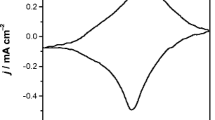Summary
The effect of methylene blue under different conditions of pH, concentration and frequency of the a. c. ripple used has been investigated on the capacity of the dropping mercury electrode. All the peaks caused by methylene blue at different pH values have been interpreted as due to the reduction of the methylene blue, as indicated by the comprehensive study of the peaks. The halt at about 0.58 Volt at pH 5.8 is due to desorption which develops into a satellite peak if potassium nitrate is used as indifferent electrolyte. It is found that the peak at 1.35 Volt at pH 12.3, first increases with increase in concentration and then diminishes at still higher concentrations. The causes of this have been discussed. The effect of frequency reveals that the reduction reactions involved are rather slow.
Zusammenfassung
Der Effekt von Methylenblau unter verschiedenen Verhältnissen von Wasserstoff-Ionen-Konzentration, Konzentration und Frequenz des überlagerten Wechselstroms auf die Kapazität der Quecksilbertropfelektrode war Gegenstand der Untersuchung. Alle dem Methylenblau zuzuschreibenden Maxima bei verschiedenen pH- Werten lassen sich interpretieren durch eine Reduktion des Methylenblau, wie die eingehende Untersuchung der Maxima zeigt. Der Konstanzbereich bei etwa 0,58 Volt und pH 5,8 ist einer Desorption zuzuschreiben, die ein Begleitmaximum entwickelt, wenn Kaliumnitrat als indifferenter Elektrolyt verwendet wird. Das Maximum bei 1,35 Volt und pH 12,3 wächst zunächst bei Steigerung der Konzentration und nimmt dann bei noch höheren Konzentrationen wieder ab. Die Gründe hierfür werden diskutiert. Der Frequenzeffekt zeigt an, daß die Reduktionsreaktionen ziemlich niedrig sind.
Similar content being viewed by others
References
Proskurnin andFrumkin, Trans. Far. Soc.31, 110 (1935).
Grahame, J. Amer. Chem. Soc.68, 301 (1946).
Doss andKalyanasundaram, Proc. Ind. Acad. Sci.35, 27 (1952).
Breyer andHacobian, Australian J. Scient. Res., s. A,5, 500 (1952).
Doss andGupta, Proc. Ind. Acad. Sci.36, 493 (1952)
Gupta, J. Sci. Ind. Res.12B, 84 (1953)
Gupta, Kolloid-Z.132, 21 (1953)
Doss andGupta, Bull. Centr. El. Res. Inst.,1, No. 2, 9 (Karaikudi 1954)
Gupta, Proc. Ind. Acad. Sci.,39, 282 (1954)
Gupta, Kolloid-Z.137, 86 (1954)
Gupta, Kolloid-Z.141, 100 (1955)
Gupta, Kolloid-Z.141, 102 (1955)
Doss andGupta, Sci. Culture22, 102 (1956).
International Critical Tables, Vol. 6, 337.
Gupta, unpublished.
Author information
Authors and Affiliations
Rights and permissions
About this article
Cite this article
Gupta, S.L. Effect of methylene blue on the capacity of the dropping mercury electrode. Kolloid-Zeitschrift 160, 30–32 (1958). https://doi.org/10.1007/BF01512074
Received:
Issue Date:
DOI: https://doi.org/10.1007/BF01512074




